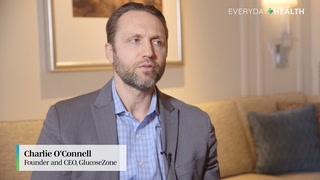Health Makers: How the App GlucoseZone Helps People With Diabetes Exercise Safely
When Charlie O’Connell was a college athlete, he lacked resources to effectively manage type 1 diabetes while staying active. So he decided to step in and create one.


When Charlie O’Connell created the digital exercise platform GlucoseZone, his goal was to create a resource for people with diabetes that had been lacking in his own life. Namely, he wanted to empower people with the condition to exercise successfully — without allowing their blood sugar to get out of whack.
“This is the dilemma facing every person in America living with diabetes: They have been told by their doctor that they need to get exercise,” says O’Connell, who lives in New Haven, Connecticut. “But while everyone knows that exercise is good for diabetes, what is not known or supported is that exercise is different for people living with diabetes, starting with the need to test their blood sugar and manage medication.”
He launched GlucoseZone as an app in November 2017, but its inspiration began nearly 20 years prior, when O’Connell tried to manage type 1 diabetes while playing football and running track at the University of Pennsylvania. He had been diagnosed with diabetes at the end of his senior year of high school.
“Ultimately, my motivation for starting the company was related to my own personal experience and frustration with the lack of guidance and support available to me as a person living with diabetes,” he says.
RELATED: The Best Diabetes Apps of the Year
Health Makers: Charlie O'Connell Talks Glucose Zone

He recalls his training schedule during college, which began with breakfast at 7 a.m. “They serve bacon, egg, cheese, and fruit, and practice is at 8,” he says. “How much insulin do you take at breakfast?”
Another example: It’s 11 a.m. and you’ve been at practice for three hours and your blood sugar is 280 milligrams per deciliter (mg/dl). According to the American Diabetes Association, the recommended range is between 80mg/dl and 130 mg/dl. “What do you do?” he asks.
“It was a total disaster because nobody there had a clue how to help me. I was the only athlete there with type 1 diabetes,” O’Connell explains.
His coaches eventually set a refrigerator aside in the training room filled with everything from maple syrup to vials of insulin. “I persevered through that situation, and I love U Penn, but at the time, it was a very frustrating experience, and I felt that diabetes had really hindered my athletic potential,” he says.
RELATED: 7 Tips for Staying Motivated to Exercise When Managing Diabetes
After graduation he moved to New York City, began working in tech, and quit exercising. The fear and anxiety he experienced during college — worrying about hypoglycemia, or low blood sugar — was so overwhelming that he lost his motivation.
“The problem was that I had come to fear my relationship with exercise,” O’Connell says. “Then I realized that I can’t have something that I really love — being active — be dominated by fear and anxiety.”
He began a personal quest to figure it out: What type of exercise should he do? Or how should he prepare for different types of exercise? Why did his blood sugar drop when he did aerobic exercise — that is, workouts of low to high intensity — and elevate when he did anaerobic exercise, or short bursts of high intensity.
“These are detailed and challenging physiological questions that type 1 diabetics have to manage every time they do physical activity,” he says. “And I realized, if this has taken me three years of studying intensely and I love exercise, what about the person who just wants to do a Spin class and not have a hypoglycemic incident?”
RELATED: 6 Diabetes Exercise Mistakes and How to Avoid Them
During this time, he learned about physiology and type 1 and type 2 diabetes, and began developing the foundation of the GlucoseZone algorithm, which takes independent variables like blood sugar, heart rate levels, and medication and analyzes them to make exercise recommendations.
“Depending on a person’s blood sugar levels, it may not be safe to exercise,” O’Connell says. “Depending on the medication profile they’re on, it may not be safe to exercise.”
GlucoseZone has teamed up with the American Diabetes Association and is being used in 20 countries. When the COVID-19 pandemic hit, he decided to offer it free for a limited time. On October 1, the app will cost $4.95, down from $12.95 before the pandemic.
“People with diabetes are more susceptible to COVID-19-related issues than the general population, and they have a requirement to be physically active on a daily basis,” O’Connell says. “My ultimate goal is to be the global resource for people living with diabetes to reach their fitness goals.”
RELATED: How Exercise Helps Prevent or Manage Type 2 Diabetes
